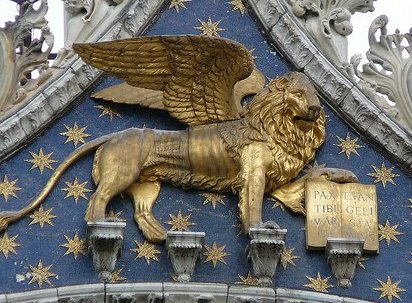|
The four gospel-writing evangelists each have a living
symbol: St John has an eagle, St. Luke a winged ox, St. Matthew a winged
man, and St Mark the winged lion. There are various suggestions for the
origins of these symbols, probably the most convincing being that they
were drawn from The Book of Revelation: And
the first beast was like a lion, and the second beast like a calf, and the
third beast had a face as a man, and the fourth beast was like a flying
eagle. And the four beasts had each of them six wings about him; and they
were full of eyes within: and they rest not day and night, saying, Holy,
holy, holy, Lord God Almighty, which was, and is, and is to come.
Rev 4. 7-8.
An alternative reading of the Lion of St Mark suggests that it is
drawn from the opening lines of St. Mark's gospel, which itself is a quote
from Isaiah:
The voice of one crying in the wilderness, Prepare ye the
way of the Lord, make his paths straight. Mark 1.3.
This idea may need some explanation. The cry in the the
wilderness could be the sound of a lion, or the voice of John the Baptist
roaring for 'all the land of Judea to repent'. The lion is also the
symbol of Judah, the house of David.
From the point of view of Venice, the lion symbol also
represents power and belligerence - a perfect representation of the city
state itself.
|
